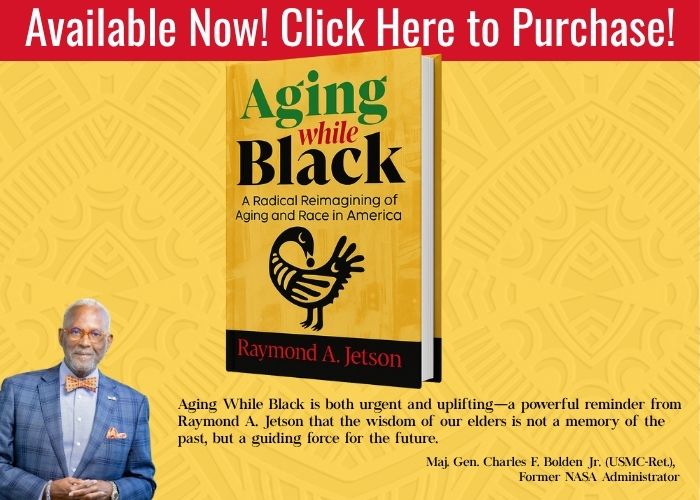Recently, we had the privilege of engaging Jo Ann Jenkins, CEO of AARP, around Aging While Black. Jo Ann brings a unique perspective to this work as a Black woman who leads not only a major organization dedicated to aging, but also the largest non-profit, nonpartisan membership organization in the world.
The conversation explored critical issues facing Black older adults, access to healthcare, building community and more. We’ll cover this important dialogue over the course of two blog posts. We ask that you not only read them, but also let us know your thoughts in the comments and on our social platforms.
How do you handle being one of very few Black leaders advocating for aging Americans?
This is a humbling question and one that we shouldn’t have to be asking. With that said, I take it very seriously as I know the weight it carries.
As a Black woman from rural Alabama, the most persistent challenges I’ve faced have come as a result of racial and gender stereotypes. Many times throughout my career, I’ve been in meetings where I looked around the room and realized that, not only was I the only woman in the room, I was the only Black person in the room. So, I always felt like I had to work extra hard to prove that I could do the job.
That’s one of the reasons why, when I became CEO of AARP in 2014, I decided to take on the challenge to Disrupt Aging—to challenge the outdated attitudes and stereotypes around aging and spark new solutions so people can live better as they age.
As a nation, we need to continuously be doing more for all older adults as people continue to live longer. Therefore, I continue to push AARP to focus on Social Security, financial security, and health care and caregiving access and affordability. I very much embrace AARP’s mission and feel as though I have a responsibility to better the lives of all people as they age, while recognizing the extraordinary challenges faced by those who have experienced decades of inequality and a lack of opportunities, including Black Americans and others.
What do you see as the most critical issue facing those of us who are Aging While Black?
There are three areas that I think are critical, both for us as individuals and for society—what I like to call Health, Wealth and Self.
For those of us who are Aging While Black, this has implications for all aspects of our lives. Think of it this way, if you knew you were going to live well into your 80s, 90s or 100, what would you do differently?
- How would it affect the way you take care of yourself—and your loved ones—your Health?
- How would it affect your work, your spending and savings habits—your Wealth?
- How would it affect your personal life, your relationships, your education, where you live—what I call your Self?
Now think about it from the broader societal view. Disrupting aging requires us to adapt our public policies, our institutions, our social structure and our infrastructure to meet the changing needs of people as they age. By focusing on health, wealth and self, not only will we begin to alter the mindset around aging we will create a society:
- Where all people can grow older knowing they have access to the care, information and services they need to lead healthier lives with independence and dignity; Health.
- Where they have the financial resources and opportunities to match their longer life expectancy; Wealth. and
- Where they are seen as an integral and inspirational asset to society. Self.
As we embrace our post-pandemic lives, health and health care has become top of mind for those of us who are Aging While Black.
Here in the United States, over the next two decades, the number of people age 65 and older will nearly double to more than 72 million — or one in five Americans. And most 65-year-olds today will live into their 90s. Some researchers believe that the first person to live to 150 is alive today. Yet, these additional years mean little unless we also increase the years in which we maintain good health. Unfortunately, the gap between our longevity—our lifespan—and our time in good health or years without disease—our health span—is increasing. We must reverse that trend. At AARP, we are engaged in a wide range of initiatives to close that gap.
For example, AARP worked for years to lower prescription drug prices, and we helped get a new law passed in 2022. As a result, the cost of insulin is now capped at $35 for people in Medicare, and the Medicare program has started to negotiate lower prices for some prescription drugs. The prescription drug law will also cap out-of-pocket prescription costs for Medicare Part D members at $2,000 starting in 2025. This has a huge impact on Black Americans.
The pandemic also shined a spotlight on the critical role that the nation’s 48 million unpaid caregivers play in caring for those who need help. Together with Federal, State and growing corporate support, we are helping to bring long-overdue recognition and support to this vital community of givers through our information, advocacy and service. Working together, we have accomplished much. But we still have much more to do. As the population ages, the demands on family caregivers are only going to increase and take an even greater toll on their physical and mental health.
Likewise, maintaining our brain health is critical, especially for those of us who are Aging While Black. Dementia is not only one of older people’s top fears, it is also one of the most urgent health inequities of our time. Communities of color and women bear a disproportionate burden. In the U.S., Black Americans are twice as likely, and Latinos are 1.5 times more likely to have Alzheimer’s disease than hon-Hispanic whites. And two-thirds of those living with Alzheimer’s and other dementias are women. At AARP, we’ve created a number of initiatives and are working with a wide range of organizations to help people maintain their brain health while also investing to help find better treatments and a cure for the various types of dementia including Alzheimer’s.
What do you believe are the critical elements of building a strong, connected and engaged community to advance Aging While Black as a movement?
We need to mentor, coach, develop and sponsor Black talent. We need to embrace the “it takes a village,” collectivist mindset to ensure we foster intergenerational succession. We cannot get complacent. We also need to give back (and give forward) to our communities. I love this quote from Maya Angelou, “Develop enough courage so that you can stand up for yourself and then stand up for someone else.” I learned this early (from my parents) and have built a career of standing up for others.
How is AARP promoting diversity and inclusion in the aging sector, particularly for older adults from marginalized communities, such as Black elders?
AARP has fought for diversity and inclusion so all people can age with independence, dignity and purpose since its founding 65 years ago. In dealing with COVID-19, however, we saw that it disproportionately affected older people (over 90% of those who died were over age 50) and communities where, historically, there has been less opportunity. In the U.S., Blacks and Latinos were hospitalized and were dying at disproportionately high rates. We realized that these disparities were not random, but instead were the result of a long history of inequality due to a lack of social, economic and political opportunities. As a result, we doubled down on our efforts to promote diversity, equity and inclusion in the aging sector, beginning in March 2021 by establishing an Office of Diversity, Equity and Inclusion (ODEI) led by an Executive Vice President and Chief Diversity Officer who reports directly to the CEO. We carry out our commitment to DEI by fighting ageism and age discrimination; addressing health and financial disparities; promoting technology and digital equity; and, when necessary, bringing legal actions to promote the rights of people aged 50 and over (especially the most vulnerable). We strive to create a more just and equitable society where everyone has the opportunity to thrive and succeed. Just a couple of examples of the work we’re doing.
- Real Conversations With AARP, Salud, Dinero y Amor – A Todo Volumen, and Our Voices Now share the lived experiences and the stories of people of color who are 50 and older. These series capture diversity and inclusion and go deep into how people have forged their paths, wrestled with obstacles, worked to advocate for their communities and other marginalized groups, and enjoyed life. These online conversations are free both to members and non-members at www.aarp.org.
- AARP has also done a lot of work around financial security. Our work here looks at fraud prevention to money mapping to financial planning. Many of our resources have been translated into several languages and support the needs of Black elders and other older adults. We offer many of these tools to both members and non-members.
- Sisters from AARP Newsletter is a weekly, digital e-newsletter designed and written by Black Women for Black Women. The topics cover Financial, Health/Wellness, Culture and Relationship information for AA/B Women 45 and older. AARP has recently celebrated the five-year anniversary of the newsletter and newsletter subscribers have surpassed 375,000 who receive the newsletter weekly. It’s available to members and non-members.
You have been a vocal advocate for improving health and wellbeing of older adults, particularly those from underserved communities. What do you see as the biggest challenges facing Black elders when it comes to accessing healthcare, and what is AARP doing to address these challenges?
AARP has found that people of color and those in the LGBTQ+ community lack trust in the health care system. Historically marginalized audiences aged 45-plus continue to feel uncared for or unheard by the medical community. Without this level of trust, people delay or put off medical care which becomes a challenge for the Black community, especially as we age.
AARP’s advocacy work has very much focused on improving the health and wellbeing of older adults, particularly those from underserved communities. I previously mentioned our work to lower prescription drug prices, to support family caregivers and to help people care for their aging brains, but our work does not stop there. For example, hearing loss can be a cause for social isolation for many older adults, so we advocated for the FDA to approve over-the-counter hearing aids for people with mild to moderate hearing loss. This has made hearing aid technology much more affordable and accessible for older adults. We also know that the lifestyle choices we make each day have more to do with our health and wellbeing than the medical treatment we receive, so we provide a wide range of resources and information to help people make more healthy lifestyle choices in their day-to-day lives.
Stay tuned for the release of this dynamic and critically importance conversation.

